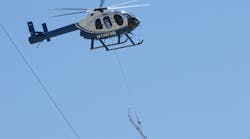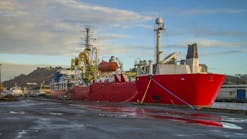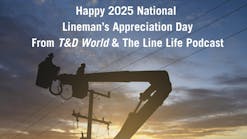For years, linemen proudly donned their climbing gear and carefully selected the most important tools to include in their belts and climbing bags. Today, the use of helicopters is becoming one of the most important resources to help linemen do their jobs in the shortest amount of time and at the lowest cost to customers.
A good example is the 500-kV, 231-mile One Nevada Transmission Line (ON Line) in Nevada, which would take significantly more time, resources and environmental impact to construct without the use of helicopters. On this project, Great Basin Transmission South, an affiliate of LS Power, and NV Energy jointly own the new transmission line, and Sturgeon Electric is providing the construction services. These three companies have joined forces with helicopter pilots and their unique transmission line construction expertise to improve construction productivity.
The ON Line project is now nearing completion and will connect the Harry Allen substation north of Las Vegas with the new Robinson Summit substation near Ely. The line will enable the development of many renewable energy projects in Nevada, connect NV Energy’s separate service areas for the first time, and allow for energy-sharing efficiencies of the utility’s power-generation resources.
In the case of this line, 844 tower structures were erected by Sturgeon’s ground crews, but the lead lines for almost 11 million ft of conductor are being flown by helicopter pilots in a wide variety of desert valleys, transition passes and mountainous areas. Additionally, the project included helicopter support for the construction of a network of microwave towers on remote mountain peaks.
Remarkably, crews and helicopter pilots worked through temperatures soaring to 120°F or more in the desert valleys. But these same crews also had to deal with snow, wind, cold and other conditions found above 7,000 ft above sea level. By having the helicopter “tool” in the lineman’s tool bag, the field workforce was able to improve its efficiency significantly, despite the adverse weather conditions.
Stringing Wire with Aerial Expertise and Ground Crews
It is estimated that a helicopter pilot, working closely with the wire crew on the ground, can accomplish the work of several tractors, bucket trucks and multiple linemen traveling cross country from one tower to the next.
During an operation to string wire, a pilot is typically the only person in the helicopter, and he or she works closely with the wire crew on the ground. To perform this operation, the helicopter pilot must be well versed in utility line construction.
The preferred helicopter tool is designed with six shorter rotor wings and the ability to use compressed air instead of a tail rotor. The aerial crew rigs a relatively standard grappling hook on the end of a steel cable that is attached to the pilot’s side of the helicopter. With this hook, the pilot can pull a thin steel lead line (often called a sock line) from tower to tower. In earlier years, linemen had to climb each tower and help insert the sock line into pulleys (often called travelers) hanging from the bottom of each insulator. With today’s improvements, these travelers are fitted with a small trapdoor assembly that the pilot can use to insert and lock in the lead line onto a pulley groove without any ground assistance.
Continuous Air-to-Ground Communication Is Vital
Linemen also must be highly qualified and specially trained to work around helicopters. For example, the linemen and equipment operators on the ground must communicate effectively with the pilot. Often, one lineman on the ground is the point person, and he or she communicates directly with the pilot in the air on a cleared radio frequency.
Communication is vital when the helicopter pilot is transporting poles or other heavy equipment or materials to the job site. The ground crew must be aware of the position of the helicopter, and through constant communication, help the pilot to position the materials or workers in the proper spot on the job site. One person often serves as the spotter, and he or she ensures that the load is safely placed in position on a tower or on the ground.
While the pilot flies the helicopter, the linemen on the ground are responsible for a variety of other tasks. For example, while the helicopter is pulling the lead line, workers on the ground monitor the tension of the wire as it is being pulled to ensure that it pays outsmoothly and doesn’t get snagged on rocks and brush or tangled up in equipment.
In some cases, it’s also necessary for the linemen to go with the pilot to perform repairs or do a specific maintenance or construction task. For example, when the pulley hanging from the insulator needs adjustment during construction, a helicopter can fly the linemen to the necessary work area by strapping them into a safety harness. The linemen are then flown into a position where they can correct the issue while dangling from a line attached to the helicopter.
Other times, the linemen may need to perform live-line maintenance, and in these situations, they often work on the live conductors from off of a skid on the helicopter. The helicopter will transport the linemen to a position near the conductor and using a wand for the initial contact, they can become “one” with the line, similar to a bird perching on an energized line. By wearing Faraday suits, the linemen become the same energized potential as the wire or equipment they are working on.
In addition, linemen rely on helicopters to get to the job site safely in situations other than live-line maintenance projects. NV Energy’s service territory spans from the desert area of Las Vegas to the mountainous region in central and northern Nevada. In many cases, the utility and its contractors depend upon helicopters to haul all of its heavy equipment, material and field workforce in and out of the job sites. This is especially important in remote regions where it may be impossible to build roads because of rugged terrain or environmental restrictions.
Performing Aerial Inspections
In addition to using helicopters for wire-stringing operations, NV Energy depends on helicopters to perform more comprehensive and accurate line inspections. On these flights, the helicopter pilot often takes linemen who conduct a thorough visual and photographic inspection.
The alternative to such aerial support is a ground patrol requiring several linemen, or patrolmen, driving the right-of-way in four-wheel-drive vehicles from one structure to the next. They then perform a visual inspection from the ground and climb individual towers as needed. This process could require several weeks to inspect the line, and unless they climb each tower, they would not be able to fully inspect the tower for loose hardware, broken ground connections or damaged insulators. With the use of a helicopter, such inspection times are measured in hours not days.
At times, these aerial inspections are performed on critical tie lines that are NV Energy’s points of connections with other utilities. Many of these lines are in remote areas and are subjected to extreme weather and vandalism. On these patrols, the linemen look for anomalies on the wire connections and also inspect the ground wire on top of the towers. In some cases, they must check the glass or porcelain insulators. In addition, they try to identify bullet-damaged conductors or insulators or anything else, which could affect the reliability of the line and cause an untimely outage to industrial, business and individual customers.
NV Energy also relies on helicopter services to perform quality-assurance inspections on new transmission line projects like the One Nevada Transmission Line. A helicopter patrol is often one of the final steps taken prior to placing a new transmission line in service. These patrols have the pilot accompanied by a journeymen lineman in the helicopter. These patrolmen are trained to recognize any deficiencies or problems, which they can record with digital photographs and then download into a report back to the project team.
By reviewing the photos of each tower, the project team can identify all problems or deficiencies such as loose nuts, missing cotter keys, or loose or missing connections. The main advantage of doing this aerial line inspection after construction is that the patrolmen can get a complete view of the towers, lines and equipment in place. Because the linemen are about 100 ft closer to the wire than they would be from the ground, they can see problems that may have gone unnoticed during the ground inspection. These problems or deficiencies can then be issued to the construction contractor in a punch list for correction prior to energizing the facilities.
By relying on helicopters for line construction, inspection and maintenance, NV Energy and its contractors have helped to improve the productivity of the field workforce.
One seasoned lineman, who recalls the earlier days of having teams of linemen climb towers to help string the lead lines that are now strung by helicopters, said, “These young transmission line workers have no idea how good they have it and how much easier the work is today than just a couple of decades ago.”
Mike Curby ([email protected]) is the supervisor of construction management for NV Energy. He has been with the utility for 24 years and oversees a team of construction administrators responsible for the bid, award and administration of the utilities transmission and substation construction contracts.
Sidebar: The Helicopter Construction Process and Nuances
Through a team effort, linemen on the ground and the helicopter pilot in the air can work together to string wire much more quickly and safely than with ground crews and bucket trucks. Here is how the wiring stringing process typically works from start to finish.
Sidebar: Five Ways Helicopters Have Helped NV Energy Field Crews
Helicopters can help to boost the productivity of the field workforce in several ways. Here are a few situations in which the utility has used helicopters to help the linemen in the field.
1. Setting poles following storms.In the wake of storm- or fire-damaged power lines, NV Energy crews have used helicopters to transport poles to reconstruction sites and then to insert the poles into freshly dug holes. This work can help restore service to customers quicker than getting traditional hauling and installation equipment in the field in remote locations.
2. Transmission line patrol. Helicopters with keen-eyed linemen are used to verify construction quality at the end of major new project construction, and they are used for routine visual inspections of in-service lines for wear, vandalism and interconnection ties.
3. New power line conductor installation. In recent years, helicopters have proven to save time and lower cost of construction, as skilled pilots can thread miles of a lead line into pulleys that facilitate the installation of new conductor lines.
4. Working in environmentally sensitive areas.Any time work must take place in environmentally sensitive areas, helicopters can airlift workers and equipment right to the job site. This eliminates the need to drive heavy equipment into sensitive areas that may require restoration as well as the chance of inadvertently introducing noxious or invasive weed species that can cling to the undersides of trucks or mud embedded into tires.
5. Assembling microwave towers. On some transmission line projects, a backup microwave system must be installed. Many of these microwave towers are built on the tops of remote mountain areas without roads; therefore, the helicopters are vital in transporting tower assemblies, equipment and even concrete for tower foundations.












